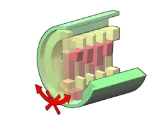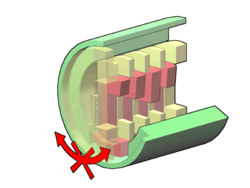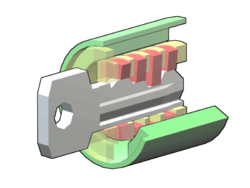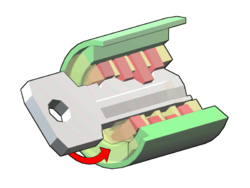
Wafer tumbler lock
Encyclopedia
A wafer tumbler lock is a type of lock
that uses a set of flat wafers to prevent the lock from opening unless the correct key is inserted. This type of lock is similar to the pin tumbler lock
and works on a similar principle. However, unlike the pin tumbler lock, the wafer is a single piece. The wafer tumbler lock is often incorrectly referred to as a disc tumbler lock
, which uses an entirely different mechanism.



wafer tumbler lock, a series of flat wafers holds a cylindrical plug in place. The wafers are fitted into vertical slots in the plug, and are spring-loaded, causing them to protrude into diametrically opposed wide grooves in the outer casing of the lock. As long as any of the wafers protrude into one of the wide grooves, rotation of the plug is blocked, as would be the case if there was no key, or if an improperly bitted key were inserted.
A rectangular hole is cut into the center of each wafer; the vertical position of the holes in the wafers vary, so a key must have notches corresponding to the height of the hole in each wafer, so that each wafer is pulled in to the point where the wafer edges are flush with the plug, clearing the way for the plug to rotate in order to open the lock. If any wafer is insufficiently raised, or raised too high, the wafer edge will be in one of the grooves, blocking rotation.
Some wafer tumbler locks use a stack of closely spaced wafers designed to fit a specific contour of a double-sided key and works on the principle of a carpenter's contour gauge.
Wafer tumbler locks can use single-bitted or double-bitted keys. Though wafer arrangements within the plug may vary, such as automotive locks, where the wafers are arranged in opposed sets, requiring a double-bitted key, the operating principle remains the same.
Unfortunately the system had reliability problems: debris from the crushed wafers often remained in the plug causing wear and occasional jamming of wafers or the plug, sometimes wafers crushed unevenly making them weak causing them to break later in use.
This system was eventually abandoned.
Locksmithing
Locksmithing began as the science and art of making and defeating locks. A lock is a mechanism that secures buildings, rooms, cabinets, objects, or other storage facilities. A key is often used to open a lock...
that uses a set of flat wafers to prevent the lock from opening unless the correct key is inserted. This type of lock is similar to the pin tumbler lock
Pin tumbler lock
The pin tumbler lock is a lock mechanism that uses pins of varying lengths to prevent the lock from opening without the correct key...
and works on a similar principle. However, unlike the pin tumbler lock, the wafer is a single piece. The wafer tumbler lock is often incorrectly referred to as a disc tumbler lock
Disc tumbler lock
A disc tumbler lock or Abloy Disklock is a lock composed of slotted rotating detainer discs. A specially cut key rotates these discs like the tumblers of a safe to align the slots, allowing the sidebar to drop into the slots, thus opening the lock. Unlike a wafer tumbler lock or a pin tumbler...
, which uses an entirely different mechanism.



Design
In a cylindricalCylinder lock
A cylinder lock is a lock constructed with a cylinder that a locksmith can easily unscrew to facilitate rekeying. The cylinder may contain any of a variety of locking mechanisms, including the pin tumbler lock, the wafer tumbler lock and the disc tumbler lock....
wafer tumbler lock, a series of flat wafers holds a cylindrical plug in place. The wafers are fitted into vertical slots in the plug, and are spring-loaded, causing them to protrude into diametrically opposed wide grooves in the outer casing of the lock. As long as any of the wafers protrude into one of the wide grooves, rotation of the plug is blocked, as would be the case if there was no key, or if an improperly bitted key were inserted.
A rectangular hole is cut into the center of each wafer; the vertical position of the holes in the wafers vary, so a key must have notches corresponding to the height of the hole in each wafer, so that each wafer is pulled in to the point where the wafer edges are flush with the plug, clearing the way for the plug to rotate in order to open the lock. If any wafer is insufficiently raised, or raised too high, the wafer edge will be in one of the grooves, blocking rotation.
Types and wafer arrangements
Wafer tumbler lock configurations vary with manufacturer. The most common is the single-bitted, five-wafer configuration most commonly found on desk and cabinet locks and some key switches. The illustrations represent this type.Some wafer tumbler locks use a stack of closely spaced wafers designed to fit a specific contour of a double-sided key and works on the principle of a carpenter's contour gauge.
Wafer tumbler locks can use single-bitted or double-bitted keys. Though wafer arrangements within the plug may vary, such as automotive locks, where the wafers are arranged in opposed sets, requiring a double-bitted key, the operating principle remains the same.
Crushable wafer tumbler lock
At one time, several manufacturers made a "crushable wafer tumbler" for these locks. The idea being to simplify the task of rekeying for locksmiths and reduce the number of different wafers that needed to be manufactured and stocked. To rekey such a lock, the locksmith simply replaced all the wafers with identical "crushable wafers", cut the new key, inserted the key into the plug, inserted the plug into a special "crushing" tool, and squeezed the handle of the tool; crushing the wafers to fit the key. It was very quick and easy.Unfortunately the system had reliability problems: debris from the crushed wafers often remained in the plug causing wear and occasional jamming of wafers or the plug, sometimes wafers crushed unevenly making them weak causing them to break later in use.
This system was eventually abandoned.

